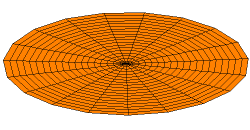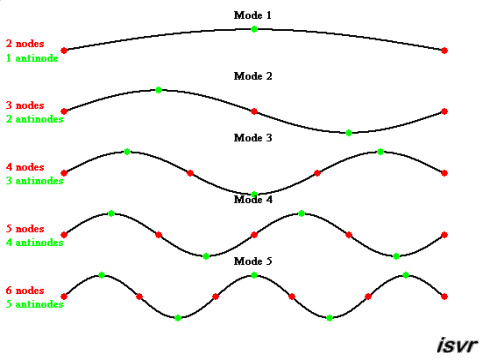Using Sound Waves You Can Produce Complex Geometry In Your Coffee!?!?

Image Credit: - Wikimedia

Introduction
Cymatics comes from the Greek word for waves, it's sometimes the name given to the field of study of vibrational mode phenomena. A pure frequency can be applied to a fluid, plate or membrane. Some people may be familiar with this where water is put into a Chinese singing bowl and once the bowl is "rubbed" it resonates and water droplets start to bounce and patterns emerge in the water. The same effect actually occurs on the membrane of a drum, which you can see in the GIF below; the GIF shows the 3rd vibrational mode. Notice it's similar to the shape you see when a droplet splashes into water.

Image Credit:- Wikimedia

The Science Behind It
For an oscillating system, a vibrational mode occurs when a standing wave is formed. The entire system moves sinusoidally at the applied frequency with a fixed angular phase. You should be familiar with standing wave on a guitar, when you pluck a string it sets up a standing wave with a specific frequency, and the result is vibration of the air inside a guitar, which results in a sound or tone being produced.

Image Credit:- soton.ac.uk-BR11 T(1-1)-1 Mode.jpg
For a given system, whether it's solid, liquid or even gas, based on the physical properties and spatial dimensions, that system will have it's own specific frequencies where these vibrational modes occur, these are called the resonant frequencies. These modes are orthogonal which means only one mode can be observed at a single time. The first mode that occurs is called the fundamental mode or 1st Harmonic, as the frequency is increased the system will go through many modes, 2nd, 3rd etc. You can see a pictorial example below which shows 1-Dimensional modes from 1st to 7th.

Image credit:- Wikimedia
For the curious minded who like equations you can see the mathematics in this PDF HERE

Vibrational Modes in 2-D and 3-D
The same physical process occurs for higher spatial dimensions, but the mathematics and physics is a bit more complicated. In 1-D the modes as pictured above, they are "string-like", however in 2-D and 3-D we start to see peculiar and beautiful patterns emerging, like in the guitar.
The image you see below is produced on something called a Chladni Plate (named after physicist and musician Ernst Chladni), usually a speaker is attached to the plate and a pure frequency generated. Then Sand or similar material is distributed onto the plate; you can just throw it on randomly, then it accumulates on at the nodes.
A standing wave of some configuration based on the physical characteristics of the plate is set up from the applied frequency. The sand is then forced into specific positions called nodes, which are positions in the wave that don't move at all, as shown in the GIF below. The red points are nodes, there is no movement at this point. The green points are antinodes, which are points in the standing wave of maximum movement. The sand self organises and rests at the nodal points.

Image Credit:- soton.ac.uk

Vibrational Mode on a Chladni Plate
Image Credit:- Pinterest
As the frequency increases the plate starts to produce higher vibrational modes (don't confuse mode with node), which creates more nodes and antinodes. This means there is more positions for the sand to rest. You can understand the idea of this with the next GIF, where the red lines are nodes. At low frequency like in mode(1,2) the sand would like to rest along the red line at the node, then increasing the frequency you may have something like mode(2,2), where there is now two red lines. This idea extends to the Chladni Plate, it vibrates just like seen in the GIF, but with a more complex pattern of course.

The same process goes for 3-D, unfortunately I couldn't find anything suitable to help you visualise it. You can imagine a cube filled with water, with speakers on each face with the exact same frequency being generated. By placing sand inside 3-D patterns would start to emerge.
In fact this phenomena is used a lot in physics, below are two links to my articles on atom cooling and sonoluminescence where this exact principle is used.
Atomic cooling
Sonoluminescence

Now for the Fun part...Try it at home!
I'll explain a way that nearly everyone will be able to do, although if your seriously interested you can make a "professional" Chladni plate and attach a big fat speaker to it.
So let's make a simple one using your mobile phone, some plastic and some salt.
First step:- Download an an app called "Frequency Generator" on your phone or other device that has a speaker.
Second step:- Find something plastic and flat like a Pringles box lid for example. Anything similar will do.
Third step:- Get some salt or sugar or something similar.
Now generate a frequency on the app, put the plastic lid over the speaker, and place the salt on the lid. Now watch the results in front of your eyes.
Note you may want to use half volume before, try experimenting. Look after your phone, don't be silly and get something stuck in the speaker. Be sensible because I won't be held responsible for exaggeration haha.
For you crazy people out there, you can try something potentially messy but fun. Get a loud speaker, place it under a table, generate a frequency and put your glass of beer or coffee on the table. Watch the liquid start dancing in front of your eyes.

For people who read this if you do try it, take a picture or video and leave it in a comment, I'd like to see your results. Have fun and be safe!
If you liked this post feel free to UPVOTE, FOLLOW, and RESTEEM.
All images are Creative Commons or public domain, no copyright infringements have occurred.
References:-
Cymatics
Normal Modes
Soton.ac.uk
Ernst Chladni - Wiki

Being A SteemStem Member
Thank You :D
Man I'm just looking at mode shapes in 2 D springs and dampers haha. I wish vibrational mechanics included sonic patterns like this one. Nice post!
P.S. I'd try to get the speakers under the table and crank it up loud. But then I'd have an audience of my neighbors at my doorstep deciding who's going to hit me first haha
It's an interesting topic. Seriously man to have deep understanding of waves and resonance effects will take someone far in physics. Tesla did and look and some of the stuff he came up with, he believed it was a key to understanding the universe.
Yeah watch those neighbours with the pitchforks or pitbulls ahah. Don't blame me is it goes that way haha. Take it easy man! :)
Wait, i love what i read, and i will like to try this out. i didnt get the steps clearly. could you please repeat them again?
Nice.... I want some pictures if you do it :P
Find an app that generates sound frequencies, one is called "frequency generator". Find something nice and flat that has edges, this you will put on the speaker to absorb the vibrations from the frequency. A PRINGLES cap is good. Then get a bit of salt, put it in the cap and put it on the speaker when there is a frequency being played through the speaker.
Try with different frequencies and see what you find. You'll notice at cetain frequencies the pattern becomes were defined and quite "perfect".
Enjoy have fun Pangoli :D
thanks bro, i will definitely do it. please remind me if i forget
You gotta try it, you'll be pleasantly surprised, watch out for exaggeration though haha. I made a mess of the museum floors before, had a bit of sand to sweep up, the speaker was too loud..... I should have know lol.